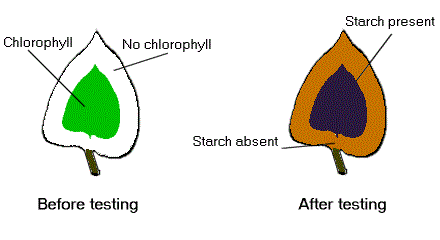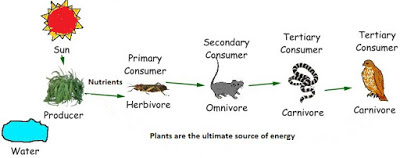7th Grade > Biology
NUTRITION IN PLANTS MCQs
:
Name of plant: 1 Mark
Name of root: 1 Mark
Cuscuta is the parasitic plant with a yellow slender tubular stem.
The special roots that penetrate deep into host plant tissues and absorb the nutrients from them are called haustoria.
:
Nutrients: 1 Mark
Use: 1 Mark
Simple sugars like glucose is produced during photosynthesis. Oxygen is produced as a byproduct.
The glucose is used by plants to generate energy for its metabolic activities. A very small portion of the oxygen produced is used by the plants for cellular respiration while the rest is released into the atmosphere. This oxygen released into the atmosphere is used by other organisms.
:
Definition: 1 Mark
Examples: 1 Mark
The mode of nutrition in which organisms take in food and digest it inside the body is called holozoic nutrition.
Examples: Humans, Amoeba, etc.
:
Explanation: 2 Marks
Examples: 1 Mark
Carnivorous plants derive some or most of the nutrients (but not energy) by trapping small animals and insects. They are adapted to grow in places where the soil is poor in nutrients, especially nitrogen. So, to obtain this nitrogen, they depend on other organisms.
Examples: Venus flytrap, Pitcher plant etc.
:
Requirements: 1 Mark
Uses in photosynthesis: 2 Marks
For performing photosynthesis, plants require the following basic components:
1. Carbon dioxide and water
2. Chlorophyll
3. Sunlight
Carbon dioxide acts as the carbon source for sugar formation.
Water provides electrons and hydrogen.
Chlorophyll is the green pigment which helps the plant to harness light energy.
Sunlight is very important as it provides the high energy required to break the hydrogen and oxygen bonds in water.
:
Explanation: 1 Mark
Examples: 1 Mark each
Symbiosis is the relationship between two organisms in which both organisms get benefited from each other.
For example, certain fungi live in the roots of trees. The tree provides nutrients to the fungus and, in return, receives help from it to take up water and nutrients from the soil. This association is very important for the tree.
In organisms called lichens, a chlorophyll-containing partner, which is algae and a fungus lives together. The fungus provides shelter, water, and minerals to the algae.
In return, the algae provide food which it prepares by photosynthesis.
:
Statement: 1 Mark
Types of heterotrophs: 1 Mark each
Green plants can sometimes be heterotrophic.
The different types of heterotrophs are parasites, symbionts, saprophytes, and insectivores.
Any two:
1. Parasitic plants obtain their nourishment from other living organisms. Example: mistletoe.
2. Symbiotic plants develop a special relationship with certain other organisms to obtain nourishment. This type of arrangement is beneficial to both the organisms involved. Example: lichens.
3. Saprophytic plants which feed on dead or decaying organic matter. They secrete digestive juices onto dead and decaying matter to break it and then absorb nutrients from it. Example: coral roots.
4. Insectivorous plants have leaves that are modified into special structures which have the ability to trap small organisms like insects. The plant then derives the nutrition from the insect by slowly digesting it. Example: Venus flytrap.
:
Experiment steps: 1 Mark each
Inference: 1 Mark
Chlorophyll is extremely important to perform photosynthesis since it is the compound responsible for harnessing sun's energy.
To prove the importance of photosynthesis, the following steps are performed in a sequential order.
Step-1: Take a beaker with boiling water and drop a croton leaf into it. Let it boil for 2 minutes (A croton leaf is a variegated leaf with white and green patches)
Step-2: Take the leaf out of the beaker and place it in a test tube with alcohol. Place this test tube in a hot water bath for 10 minutes. Alcohol decolourises the leaf by removing chlorophyll from it by the process of bleaching.
Step-3: Remove the leaf from alcohol and wash it with warm water. Place it on a tile for further test.
Step-4: Add 2 drops of iodine onto the leaf. The portions which were green i.e. contained chlorophyll turn into bluish-black colour indicating a positive test for starch. The portions which did not contain chlorophyll and did not participate in photosynthesis turns brown because of the iodine solution indicating a negative test for starch.
This experiment proves that food, or starch, is made only in the places of the leaves which are green, or in other words, have chlorophyll in them. So we can conclude that chlorophyll is necessary to perform photosynthesis.
:
Each part: 1 Mark
1. Organisms that live together and get mutually benefited - Symbionts.
2. Pitcher plant has both autotrophic and heterotrophic mode of nutrition.
3. Stomata are the pores through which leaves exchange gases.

















